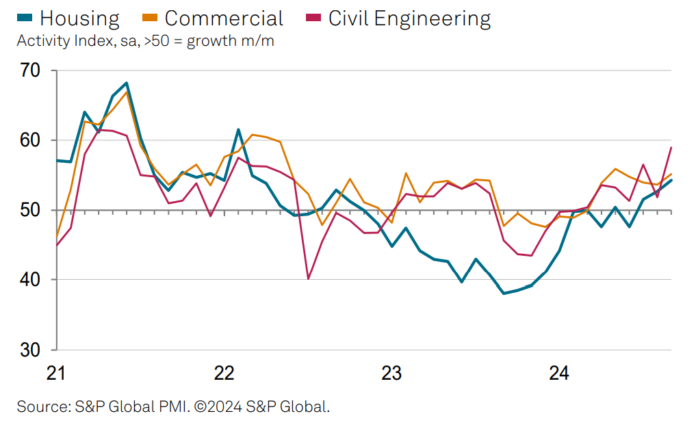September data has indicated that business activity growth across the UK construction sector accelerated to its fastest for nearly two-and-a-half years.
The headline S&P Global UK Construction Purchasing Managers’ Index (PMI) posted 57.2 in September, up from 53.6 in August and above the neutral 50.0 threshold for the seventh successive month. The latest reading signalled a strong upturn in total construction activity and the steepest rate of growth for 29 months.
New work also expanded markedly, with rising demand attributed to increased willingness-to-spend among clients and a more supportive economic backdrop.
Breakdown
Faster rates of output growth were seen in all three sub-sectors monitored by the survey in September. Civil engineering (index at 59.0) was the best-performing category, with survey respondents commenting on robust demand for renewable energy infrastructure and a general uplift in work on major projects.
Commercial building (55.2) also gained momentum in September, with output levels rising to the greatest extent since May. A number of firms noted that lower borrowing costs and domestic political stability had a positive impact on client spending, although survey respondents also noted tight budgets.
Improving market conditions and rising confidence also helped to boost house building in September (54.3). The latest upturn in residential work was the fastest since March 2022, but still softer than seen elsewhere in the construction sector.
Workloads
Total new orders expanded at the strongest rate for two-and a-half years in September. Greater workloads encouraged additional staff recruitment, despite some firms noting that cost pressures had led to delays with the replacement of voluntary departures. Employment levels have now increased in four of the past five months.
Material demands
Demand for construction products and materials meanwhile increased at a solid pace. The latest expansion of input buying was one of the fastest seen since early-2022. Suppliers’ delivery times nonetheless shortened again in September, which was linked to rising stocks among vendors.
Furthermore, some construction companies noted concerns about the outlook for steel prices and supply conditions due to recent closures of domestic blast furnaces.
Overall input prices increased for the ninth month running and at the steepest rate since May 2023. Construction companies commented on higher prices paid for a range of raw materials, as well as the pass-through of higher wages by suppliers. Rates charged by subcontractors nonetheless increased only marginally and at the slowest pace so far in 2024.
Looking ahead
Finally, business activity expectations for the year ahead remained upbeat in September despite slipping to the lowest since April. Optimism was often centred on prospects for sustained growth in the house building sector.
Industry comments
Atul Kariya, head of real estate and construction at MHA, commented: “Construction PMI has jumped to 57.2, suggesting that the construction industry is steadily moving to firmer ground. With the election behind us and more economic stability there is hope that investment will begin to flood into the sector. All three subsectors have shown growth over the last month which is positive news. Order books remain strong, which has been the case for the last few months and there is hope that the delays that there have been in getting building started will now be subsiding.
“However, there are several headwinds facing the sector. While the announcement of Labour’s housing plan has been welcomed, our clients are telling us that the uncertainty as to further announcements in this month’s Budget is causing concern. They are hoping that it will bring more clarity, which will provide more confidence to investors, developers and contractors. It is also essential that the Building Act Safety Gateways do not unduly delay the start of projects.
“As Construction PMI is a leading economic indicator, it could mean that we are starting to get an indication that there may be brighter times ahead.”
Terry Woodley, MD of development finance at Shawbrook, commented: “The UK construction sector has continued to grow, with both commercial activity and new orders seeing sustained activity over the past month. No doubt this has been helped by the government’s recent focus on the sector, with increased housing targets, promises of more planning officers, and a proposed relaxing of red tape being well received by developers.
“With the Autumn Budget due at the end of the month, developers are turning their attention to what else the government may have in store, especially regarding the recent announcement on ‘brownfield passports’ which seek to support developers in acquiring urban sites. While more detail on the expected planning reforms are needed, it is encouraging to see the government doing more to bolster the sector and bodes well for the long-term outlook.”




